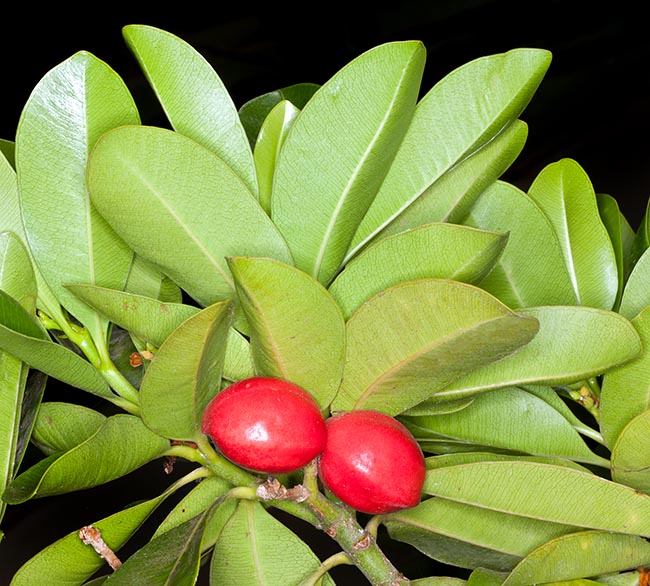Family : Apocynaceae

Text © Pietro Puccio

English translation by Mario Beltramini

Ochrosia elliptica is a 4-8 m shrub. Toxic fruits, but bark and leaves are medicinal © Giuseppe Mazza
The name of the genus comes from the Greek “ochros” = pale yellow, with reference to the colour of the wood; the name of the species from the Latin adjective “ellpticus, a, um” = elliptic, with reference to the shape of the leaf.
Common names: berrywood tree, bloodhorn, elliptic yellowwood, kopsia, lipstick tree, mangrove ochrosia, New Caledonia tree, pokosola, red berrywood, scarlet wedge-apple, wedge apple (English); faux cafeiér, faux quinquina (French).
The Ochrosia elliptica Labill. (1824) is an evergreen shrub or small tree 4-8 m tall with ashy yellow colour and mlky sap.
The leaves, on a 0,5-2 cm long petiole, are opposite or more frequently arranged in 3-4 verticils, simple, entire, obovate-ellptic with acute or obtuse apex, coriaceous, of glossy intense green colour above, paler below, 5-18 cm long and 3-8 cm broad.
The inflorescences are axillar or terminal cymes carrying numerous odorous hermaphroditic flowers, cream white to yellowish, with calyx with 5 obtuse lobes 0,2 cm long, corolla with tubular base 1-1,5 cm long and 5 ovate-oblong lobes of about 0,7-1 cm of length. The fruits, toxic, are almost ellipsoid drupes with pointed apex, usually in pair, of bright red colour when ripe, from which exudes sticky latex when incised, 3-6 cm long and of 2-4 cm of diameter, with woody endocarp containing 2-6 orbicular seeds with narrow wing. It reproduces by seed, previously scarified, in draining sandy loam kept humid, at the temperature of 22-24 °C with germination times of 1-2 months, and by cutting. The dispersion of the fruits is facilitated by the two lateral cavities present when ripe in the endocarp which allow its floating and the transportation by means of the oceanic currents.
It is a species with showy fruits, of rather slow growth, cultivable in the tropical and subtropical zones, as it does not bear temperatures close to 0 °C if no for exceptional and for very short time, in full sun or partial shade on various types of soil, provided perfectly draining, acidic to alkaline, sandy or rocky; well rooted, it can resist to long drought periods, even if it takes advantage from regular irrigations. Due to its resistance to the saline aerosols it can be utilized in gardens close to the sea, even if the high toxicity of the fruits recommends a prudent use; it is also utilized for the consolidation of the sandy zones close to the sea.
The bark is used in the traditional medicine for some pathology; from the leaves they have extracted cytotoxic indolic alkaloids, in particular ellipticine, whose synthetic derivatives, with less serious secondary effects and greater selectivity, have proved having great interest as anticancer substances.
Synonyms: Ochrosia parviflora G.Don (1837); Bleekeria calocarpa Hassk. (1855); Bleekeria kalocarpa Hassk. (1855); Lactaria calocarpa (Hassk.) Hassk. (1856); Ochrosia calocarpa (Hassk.) Miq. (1869); Lactaria elliptica (Labill.) Kuntze (1891); Lactaria parviflora (G.Don) Kuntze (1891); Bleekeria elliptica (Labill.) Koidz. (1923); Excavatia elliptica (Labill.) Markgr. (1936); Ochrosia noumeensis Baill. ex Guillaumin (1941).
→ To appreciate the biodiversity within the APOCYNACEAE family please click here.
